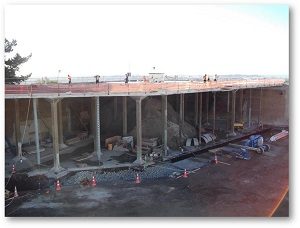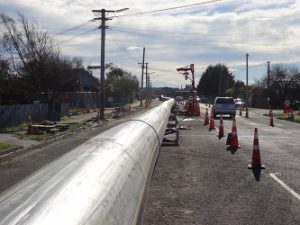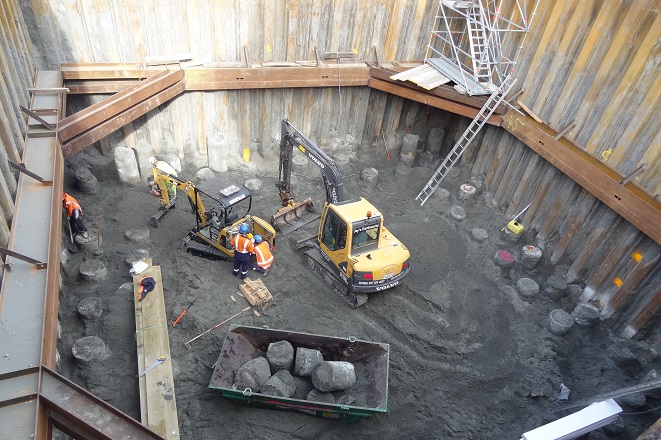This paper, ‘A seismic shift in design – embedding safety, resilience and value into post-earthquake designs’, was presented at Water New Zealand’s Annual Conference. Beca Christchurch’s Ian Macbeth (manager Christchurch – water, & principal – environmental), Iain Partington (technical director, project management) and Gavin Hutchison (associate – civil engineer) and Christchurch City Council ‘s John Moore (planning and delivery manager, 3Waters and waste.)
ABSTRACT
The post-earthquake 3-waters infrastructure rebuild in Christchurch has provided an opportunity to fully integrate safety in design (SiD) and value engineering into designs. With seismic resilience being fundamental to these designs, there is also a need to balance financial constraints imposed by insurance payments on one hand, with a focus on incorporating whole-of-life safety considerations on the other.
These apparently conflicting drivers have emboldened designers to go beyond conventional conservative designs to come up with smart, cost-effective solutions. It has also required clients to be engaged in the journey, sometimes taking them outside their comfort zone.
Solutions have utilised unconventional equipment and materials, pared-down structures, novel configurations and innovative repair and remediation methodologies. In some instances, resilience has moved from ‘unbreakable’ to ‘easily repairable’.
Our full paper summarises some of these innovative solutions, using delivered examples from the Christchurch rebuild, as well as one built elsewhere, applying the learnings from Christchurch. It highlights the need to have the right people, from multiple disciplines, involved in projects from the outset; to challenge conventional wisdom in delivering safe, resilient, yet cost-effective, infrastructure for our communities.
INTRODUCTION

The Canterbury earthquake sequence has been characterised by a host of big numbers. Since the first earthquake, of 7.1-magnitude at 4:35am on September 4, 2010, centred around 40 kilometres west of Christchurch, we’ve experienced over 14,000 quakes – and counting. The most damaging 6.3-magnitude earthquake on February 22, 2011, centred only five kilometres beneath a south-eastern suburb of the city, recorded a maximum peak ground acceleration of 2.2g; one of the highest ever recorded.
Something like 400,000 tonnes of liquefied sand and silt have been removed from the streets and sewerage system of Christchurch. Within the ‘Four Avenues’ of the main city centre, some 1240 buildings have so far been demolished. The central city cordon was in place, manned by army personnel, for 860 days. The Crown-designated ‘Residential Red Zone 1’ extends over some 830 hectares and more than 8000 houses. Around 100,000 houses were damaged, of which some 10,000 have required complete demolition.
About 100 wastewater pumping stations have needed to be rebuilt or repaired. Of 1700 kilometres of sewers in Christchurch, more than 500 kilometres (around 30 percent) were damaged. In the order of 2000 portaloos and 40,000 chemical toilets were deployed during the earthquake sequence. Approximately 50 kilometres of water pipes were damaged. Of the city’s 175 water wells, all but 64 have required repair; 22 were irreparably damaged.
Vertical ground movement through tectonic uplift and differential settlement has been widespread; ranging from up to 0.5 metres uplift in the areas of the Port Hills, to one metre settlement in areas near the Avon River – highly significant in a flat city predominantly relying on gravity drainage of sewage and stormwater. Furthermore, 1021 kilometres of Christchurch’s urban sealed roads (52 percent of the total) have needed repair. Over half the city’s 225 bridges have required repair or complete rebuilds.
The cost to repair the city’s horizontal infrastructure (roads, bridges and the 3-waters infrastructure of water, wastewater and stormwater) is estimated to be around $2.5 billion; approximately half of which is in repairing or replacing gravity pipe systems. Overall, it is reputed to be one of the most expensive insured natural disasters in history.
Underpinning these bare facts is, of course, the most tragic: 185 people died in the 22 February 2011 earthquake.
Despite all the trauma, damage and disruption, the earthquakes have provided a once-in-a-lifetime, career-defining opportunity for the engineering community. The chance to rebuild a city, creating a lasting legacy of a stronger, modern and world-class urban environment has provided an opportunity that many have relished. Besides locals, scores have come from around New Zealand and from all over the world to play their part.
Based on the collective experience gained – of failure mechanisms, of repair strategies, of the value of multi-disciplinary inputs to design, and incorporating modern materials and techniques – a number of design standards and practices have changed. The significance of the earthquakes on our design environment cannot be underestimated; at a national level, our designs can be considered those completed in the ‘pre-Christchurch’ world and those ‘post-Christchurch’.
Our full paper focuses on innovative examples of 3-waters (water, wastewater and stormwater) rebuild projects from the city’s infrastructure networks. It also provides an example of a project completed in Marlborough; one of the first ‘post-Christchurch’ projects to apply the learnings in creating safe, innovative and resilient infrastructure elsewhere.

Most of the described projects are ones in which Beca staff have been involved. With a long and close relationship with Christchurch City Council (CCC), the owner of the city’s 3-waters infrastructure assets, Beca has provided design services for many of the most complex rebuild projects. This has been through either direct engagement by CCC, or by designers working alongside those from other consultants within the SCIRT alliance (described below).
Since its creation in mid-2011, the repair, rebuild and replacement of the city’s earthquake-damaged horizontal infrastructure has been the responsibility of SCIRT; the Stronger Christchurch Infrastructure Rebuild Team. Its mission is “creating resilient infrastructure that gives people security and confidence in the future of Christchurch”.
The alliance comprises three asset owners: CCC, the Canterbury Earthquake Recovery Authority (CERA) and the New Zealand Transport Agency (NZTA), along with five non-owner participants: namely, contractors City Care, Downer, Fletcher Construction, Fulton Hogan and McConnell Dowell. Servicing the alliance have been four design teams of consultant engineers and CCC staff; co-located in a dedicated project team environment.
Beca staff formed the core of one of the four teams; the Red Team, designing the majority of the pump stations for the rebuild. At its peak in late 2011 – 2014, the design teams totalled around 160 staff (approximately 40 per team), although now ramping down as design works are scheduled for completion in late 2016. By then, SCIRT will have managed more than 700 construction jobs.
A key feature of the SCIRT alliance has been Early Contractor Involvement (ECI). Combining asset owners, designers and contractors in a ‘one-team’ environment has facilitated construction input into designs, whereby constructability opportunities, issues and risks are identified and taken into account. In doing so, innovation, safety and value have all been enhanced at an early stage for the designs and installations.
Throughout its lifespan, one of SCIRT’s objectives has been to foster a learning and sharing culture, both within the organisation and beyond; creating a legacy of knowledge and intellectual property to be shared, not only amongst all the participants, but beyond to the wider industry. To this end, a number of technical papers have been produced on the learnings from SCIRT, such that we now have a significant body of literature and design experience that can be applied in future designs. A select range of SCIRT-derived papers, presented at technical conferences, forms part of the reference list to this paper.
One specific and critical area of infrastructure excluded from SCIRT’s remit is the Christchurch Wastewater Treatment Plant (CWTP), owned and operated by CCC. At this site, CCC has had a standing agreement with Beca to provide professional services since mid-2008. Because of Beca’s history and intimate knowledge of the site, it was rapidly able to deploy staff to the response, recovery and rebuild process, in close collaboration with CCC staff. Experience of this process at the CWTP is referenced in our paper.
Details within this paper have wider reference for territorial authorities around New Zealand, and beyond. The Local Government Act 2002 requires councils to prepare an infrastructure strategy with a minimum 30-year horizon. As noted by McFarlane (2015), a council’s strategy must outline how its assets will be managed, including providing for resilience in “identifying and managing risks related to natural hazards and by making appropriate financial provision for those risks”. He does point out, however, that it is often difficult for councils to justify resilience improvements against other projects that provide more immediate and tangible benefits.
Nonetheless, research shows the massive payback of pre-emptive mitigation measures. McFarlane quotes the example of Orion, central Canterbury’s electricity network provider, which estimated the $6 million previously spent on seismic strengthening saved $30 million – $50 million in direct asset replacement costs following the Canterbury earthquakes. There is, therefore, a compelling case for incorporating resilient features into business-as-usual upgrades of infrastructure assets.
This article was first published in the February 2017 issue of NZ Local Government Magazine.



